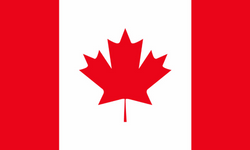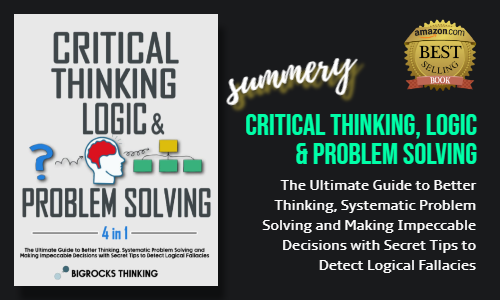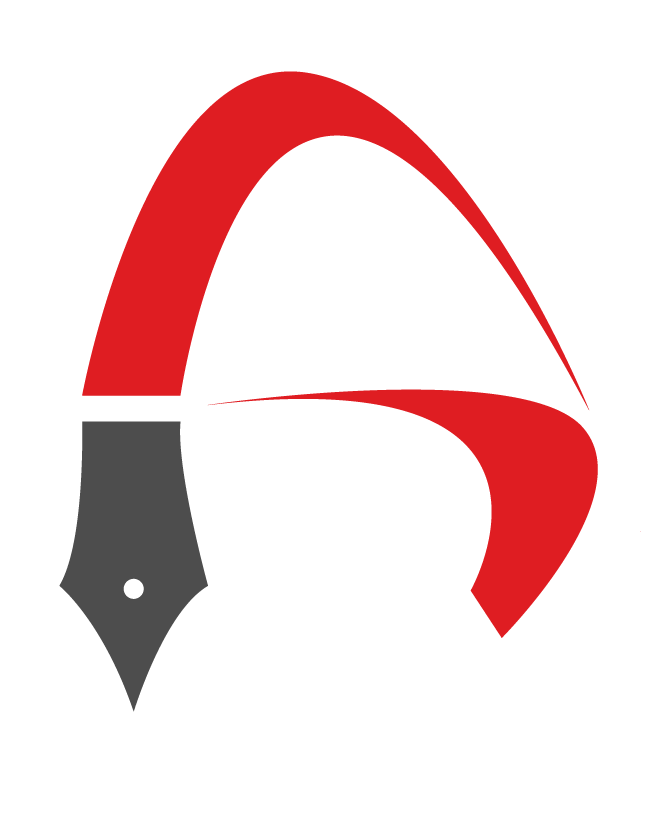Critical thinking, logic, and problem-solving are essential skills that can help anyone achieve their goals and overcome their challenges. However, many people struggle with these skills, either because they lack the knowledge, the practice, or the confidence to apply them. This book aims to provide a comprehensive and practical guide on how to master these skills and use them effectively in various situations.
About the author and the book and its success:
The author of this book is Bigrocks Thinking, a company that specializes in creating educational content on topics such as critical thinking, logic, psychology, and philosophy. Bigrocks Thinking’s mission is to help people improve their mental abilities and achieve their goals. The book consists of three parts plus a bonus: Critical Thinking, Logic, Structuring & Framing, Problem Solving, and Logical Fallacies. The book has received positive reviews from readers who praised the clear explanations, engaging style, and useful exercises. The book has also been a bestseller on Amazon in categories such as Logic & Language, Decision Making & Problem Solving, and Philosophy.
The Central Idea:
The central idea of this book is that critical thinking, logic, and problem-solving are interrelated skills that can be learned and improved with practice. The book provides a comprehensive guide on how to develop these skills through a step-by-step process that covers the basics of critical thinking, the principles of logic, the methods of problem-solving, and the tips to detect logical fallacies. The book also provides practical advice on how to apply these skills in various situations and domains.
Punch Lines:
Some of the punch lines from this book are:
- “Critical thinking is not a gift. It’s a skill that can be learned and improved with practice.”
- “Logic is not a mystery. It’s a tool that can help you structure your thoughts and arguments.”
- “Problem-solving is not a talent. It’s a process that can help you find solutions and make decisions.”
- “Logical fallacies are not inevitable. They are errors that can be avoided and corrected.”
Important Points:
Some of the important points from this book are:
- Critical thinking involves asking questions, evaluating evidence, analyzing arguments, identifying assumptions, avoiding biases, and drawing conclusions based on logic and reason.
- Logic involves using rules and methods to construct valid arguments and evaluate their soundness. Logic can be divided into deductive logic (based on certainty) and inductive logic (based on probability).
- Problem-solving involves defining the problem, gathering information, generating alternatives, evaluating options, implementing solutions, and reflecting on outcomes. Problem-solving can be divided into analytical problem-solving (based on logic) and creative problem-solving (based on imagination).
- Logical fallacies are errors in reasoning that can undermine the validity of an argument or a claim. They can be intentional or unintentional, and they can be classified into formal fallacies (based on the structure of an argument) or informal fallacies (based on the content or context of an argument).
The book is divided into four parts. Let take a look at each part in detail.
Similar to this Book: Critical Thinking & Logic Mastery - 3 Books In 1
Part 1: Critical Thinking
This part introduces the basics of critical thinking and how to apply it in various situations. It covers the following topics:
- Chapter 1: What is Critical Thinking? This chapter defines critical thinking as the ability to think clearly, rationally, objectively, creatively, independently, analytically, reflectively, ethically, and strategically. It also explains why critical thinking is important for personal and professional success.
- Chapter 2: Benefits and Challenges of Critical Thinking. This chapter discusses the benefits of critical thinking such as improving decision-making, problem-solving, communication, learning, creativity, self-confidence, self-awareness, emotional intelligence, resilience, happiness, and well-being. It also discusses the challenges of critical thinking such as cognitive biases, emotional influences, social pressures, information overload, and lack of time, resources, or motivation.
- Chapter 3: Elements and Standards of Critical Thinking. This chapter introduces the elements and standards of critical thinking as proposed by Richard Paul and Linda Elder, two of the most influential critical thinking experts. The elements of critical thinking are the components of reasoning that can be used to analyze any issue or problem. They are: purpose, question, information, inference, assumption, point of view, concept, and implication. The standards of critical thinking are the criteria that can be used to evaluate the quality of reasoning. They are: clarity, accuracy, precision, relevance, depth, breadth, logic, significance, and fairness.
- Chapter 4: Asking Good Questions. This chapter explains how to ask good questions that can stimulate critical thinking and elicit useful information. It covers the types of questions such as open-ended, closed-ended, factual, analytical, evaluative, and creative questions. It also covers the techniques of questioning such as probing, clarifying, challenging, summarizing, and reflecting.
- Chapter 5: Evaluating Sources of Information. This chapter explains how to evaluate sources of information that can provide evidence for critical thinking. It covers the criteria of credibility such as authority, accuracy, objectivity, currency, and coverage. It also covers the methods of verification such as cross-checking, corroboration, triangulation, and citation analysis.
- Chapter 6: Analyzing Arguments. This chapter explains how to analyze arguments that can support or oppose a claim or a position. It covers the structure of arguments such as premises, conclusions, and inferences. It also covers the types of arguments such as deductive, inductive, abductive, and analogical arguments.
- Chapter 7: Identifying Logical Fallacies. This chapter explains how to identify logical fallacies that can weaken or invalidate an argument or a claim. It covers the common types of logical fallacies such as ad hominem, straw man, slippery slope, false dilemma, appeal to authority, etc.
- Chapter 8: Avoiding Cognitive Biases. This chapter explains how to avoid cognitive biases that can distort or impair your judgment and reasoning. It covers the common types of cognitive biases such as confirmation bias, availability heuristic, anchoring effect, framing effect, hindsight bias, etc.
- Chapter 9: Making Sound Decisions. This chapter explains how to make sound decisions using critical thinking skills. It covers the steps of decision-making such as defining the problem, identifying the criteria, generating alternatives, evaluating options, choosing the best option, implementing the decision, and reviewing the outcome.
- Chapter 10: Solving Problems Effectively. This chapter explains how to solve problems effectively using critical thinking skills. It covers the steps of problem-solving such as defining the problem, gathering information, generating alternatives, evaluating options, choosing the best solution, implementing the solution, and reflecting on the outcome.
Part 2: Logic
This part introduces the basics of logic and how to apply it in various situations. It covers the following topics:
- Chapter 11: What is Logic? This chapter defines logic as the study of valid reasoning and argumentation. It also explains why logic is important for critical thinking and communication.
- Chapter 12: Principles and Methods of Logic. This chapter introduces the principles and methods of logic that can be used to construct and evaluate arguments. It covers the concepts of validity, soundness, consistency, completeness, and coherence. It also covers the methods of logic such as truth tables, Venn diagrams, syllogisms, propositional logic, predicate logic, modal logic, and informal logic.
- Chapter 13: Deductive Logic. This chapter explains deductive logic as a type of logic that is based on certainty and necessity. It covers the rules of deductive logic such as modus ponens, modus tollens, hypothetical syllogism, disjunctive syllogism, etc. It also covers the common forms of deductive arguments such as categorical syllogisms, conditional syllogisms, and dilemmas.
- Chapter 14: Inductive Logic. This chapter explains inductive logic as a type of logic that is based on probability and evidence. It covers the rules of inductive logic such as generalization, analogy, causation, correlation, etc. It also covers the common forms of inductive arguments such as induction by enumeration, induction by analogy, induction by causation, induction by correlation, etc.
- Chapter 15: Abductive Logic. This chapter explains abductive logic as a type of logic that is based on inference and explanation. It covers the rules of abductive logic such as inference to the best explanation, Occam’s razor, etc. It also covers the common forms of abductive arguments such as abduction by elimination, abduction by plausibility, abduction by coherence, etc.
- Chapter 16: Analogical Logic. This chapter explains analogical logic as a type of logic that is based on similarity and comparison. It covers the rules of analogical logic such as relevance, proportionality, sufficiency, etc. It also covers the common forms of analogical arguments such as positive analogy, negative analogy, argument from analogy, and argument by analogy.
Part 3: Problem Solving
This part introduces the basics of problem solving and how to apply it in various situations. It covers the following topics:
- Chapter 17: What is Problem Solving? This chapter defines problem solving as the process of finding solutions to problems or challenges. It also explains why problem solving is important for critical thinking and creativity.
- Chapter 18: Types & Stages of Problem Solving. This chapter introduces the types and stages of problem solving that can be used to tackle different kinds of problems or challenges. It covers the types of problem solving such as analytical problem solving (based on logic) and creative problem solving (based on imagination). It also covers the stages of problem solving such as defining the problem, gathering information, generating alternatives, evaluating options, choosing the best solution, implementing the solution, and reflecting on the outcome.
- Chapter 19: Tools and Techniques for Problem Solving. This chapter introduces various tools and techniques that can be used to enhance problem solving skills and performance. It covers the tools and techniques such as mind maps, SWOT analysis, pro-con lists, brainstorming, lateral thinking, six thinking hats, etc.
- Chapter 20: Obstacles and Challenges for Problem Solving. This chapter discusses the common obstacles and challenges that can hinder problem solving performance and how to overcome them. It covers the obstacles and challenges such as procrastination, distraction, stress, fear of failure, mental blocks, groupthink, etc.
Part 4: Logical Fallacies
This part introduces the basics of logical fallacies and how to detect them in your thinking and communication. It covers the following topics:
- Chapter 21: What are Logical Fallacies? This chapter defines logical fallacies as errors in reasoning that can undermine the validity of an argument or a claim. It also explains why logical fallacies are harmful for critical thinking and communication.
- Chapter 22: Types and Categories of Logical Fallacies. This chapter introduces the types and categories of logical fallacies that can be encountered in various situations and domains. It covers the types of logical fallacies such as formal fallacies (based on the structure of an argument) or informal fallacies (based on the content or context of an argument). It also covers the categories of logical fallacies such as fallacies of relevance, fallacies of ambiguity, fallacies of presumption, fallacies of inconsistency, etc.
- Chapter 23: How to Recognize and Refute Logical Fallacies. This chapter explains how to recognize and refute common logical fallacies that can appear in everyday situations such as politics, media, advertising, education, etc. It covers the common logical fallacies such as ad hominem, straw man, slippery slope, false dilemma, appeal to authority, etc. It also provides examples and tips on how to spot and counter these fallacies.
- Chapter 24: How to Avoid Committing Logical Fallacies Yourself. This chapter explains how to avoid committing logical fallacies yourself and improve your reasoning skills. It covers the strategies such as checking your premises, testing your conclusions, considering alternative perspectives, seeking feedback, and learning from your mistakes.
Bonus: Secret Tips to Detect Logical Fallacies
This bonus provides some secret tips that can help you detect logical fallacies more easily and effectively. It covers the tips such as:
-
Look for emotional triggers
-
Look for vague or ambiguous terms
-
Look for missing or distorted evidence
-
Look for false or questionable assumptions
-
Look for contradictions or inconsistencies
Analysis:
This book is an excellent resource for anyone who wants to improve their critical thinking, logic, and problem-solving skills. It covers the essential concepts and principles of these skills in a clear and concise way, with plenty of examples and exercises to reinforce learning. It also provides practical advice on how to apply these skills in various situations and domains. The book is well-organized, well-written, and well-designed. It is suitable for beginners who want to learn the basics of critical thinking, logic, and problem-solving, as well as for advanced learners who want to deepen their understanding and practice of these skills.
Who should read this book:
This book is recommended for anyone who wants to:
-
Make smarter decisions in their personal and professional lives
-
Conquer logical fallacies that can distort their thinking
-
Sharpen their thinking and become more independent thinkers
-
Enhance their creativity and problem-solving abilities
-
Boost their confidence and self-esteem
-
Learn new things and expand their knowledge
Lessons to Learn:
Critical thinking, logic, and problem-solving are not innate talents. They are skills that can be learned and improved with practice.
- Critical thinking, logic, and problem-solving can help you avoid common pitfalls that can impair your judgment and reasoning.
- Critical thinking, logic, and problem-solving can help you achieve your goals and overcome your challenges.
- Critical thinking, logic, and problem-solving can enrich your life

























